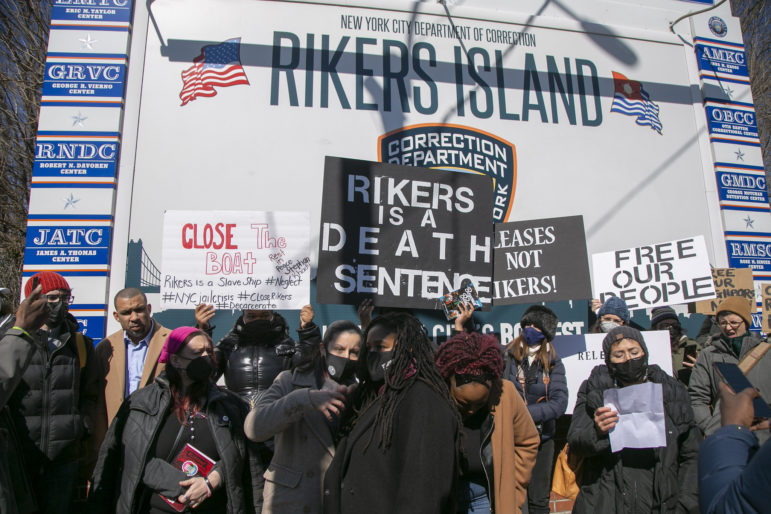“Rikers Island is not a necessary institution. There are plans and legislation underway that will remove our neighbors and fellow New Yorkers off of Rikers and into a smaller system borough-based facilities. This would bring families closer to their loved ones, improve conditions for people detained, and end our over-reliance on incarceration.”

William Alatriste/NYC Council Media Unit
Elected officials and activists at a rally at Rikers Island in February 2022.Last year 19 people died in NYC Department of Correction (DOC) custody, making it the deadliest year in more than a decade. Two weeks from late August to mid-September were particularly deadly, and particularly disturbing for me.
I know the toxicity that permeates Rikers Island. I spent two years there at the age of 16. I remember arguments, fights, and attempted suicides in the unit where I lived. I once saw officers escort a woman down the hall in a mask that reminded me of Hannibal Lector. But I never saw or heard of so many deaths as there are now. A stay at Rikers can be a death sentence for those suffering from mental health disorders. With poor assessments, mental health disorders go undiagnosed, and with officers ignorant of the symptoms, suicides are inevitable.
On Sept. 14, Kevin Bryan, 35, became the 14th person to die while under the supervision of correctional officers last year. Bryan, detained for alleged burglary and dealing with drug dependency at the time, was pronounced dead after a group of men attacked him. Reports say that Bryan got away from his attackers, ran, and locked himself into a bathroom assigned for officers, where he hung himself. Bryan had only been there a week.
Bryan’s death came a little over two weeks after Michael Nieves, 40, slit his throat, and an officer watched him bleed out for 10 minutes before getting any assistance. Nieves lingered for four days before being taken off of life support. He was arrested for burglary, arson, and other offenses and diagnosed with schizophrenic disorder. Nieves was sent to a psychiatric hospital for evaluation on two separate occasions and deemed unfit to stand trial. He died before his next court appearance.
Both deaths show that not only is Rikers a death trap, it’s the largest de facto mental health facility in New York State.
COVID has made Rikers Island a petri dish, both literally and figuratively. Staffing shortages occurred as the pandemic spread throughout the facility. Union officials have defended the officers, saying they were exhausted from working overtime and morale was low. The mental health of everyone is at stake. I can’t help but think of what was going on in that officer’s mind to watch a man bleed out.
In 2017, after intense pressure from directly impacted people and communities, Mayor Bill de Blasio decided it was time to close the failing jail complex, and initiated a process that culminated in the City Council approving a comprehensive plan to close the 10 jails on Rikers, and their extension, The Boat, by 2027. In 2021, City Council followed up by passing Renewable Rikers legislation requiring the DOC to gradually turn over Rikers Island to the Department of Citywide Administrative Services (DCAS) to be used for green infrastructure. The law set up a process for transferring unused land and facilities twice a year until Aug. 31, 2027, when all the land must be transferred.
Mayor Eric Adams has stalled that timeline with his refusal to surrender land to DCAS, citing his expectation (or more accurately, his intention) for the jail population to increase. To create the appearance of addressing “public safety,” he has chosen to arrest people for fare evasion, and called for judges to send more people to Rikers on bail amounts they can’t afford.
In doing so, Mayor Adams has neglected to follow his own stated intention of focusing attention “upstream,” like funding supportive housing and community-based treatment to address mental health issues. He’s decided instead that we need more officers on the streets, reviving the “broken windows” policing that contributed to mass incarceration in the first place. Mayor Adams needs to stop the bravado and do his job to preserve human life and create real safety for our communities.
Rikers Island is not a necessary institution. There are plans and legislation underway that will remove our neighbors and fellow New Yorkers off of Rikers and into a smaller system borough-based facilities. This would bring families closer to their loved ones, improve conditions for people detained, and end our over-reliance on incarceration.
Over 1,000 people are locked up at Rikers on an average day who are diagnosed with severe mental illness. Funding treatment in communities will shrink the jail population and save the city money. With over $550,000 spent per year to incarcerate one person on Rikers, we have an incredible opportunity to instead use that money to get people the help they need, instead of casting them off to an isolated island to await death.
Hope Sanders is an active member of Freedom Agenda. She spent two years incarcerated in Rikers Island as a teenager.








